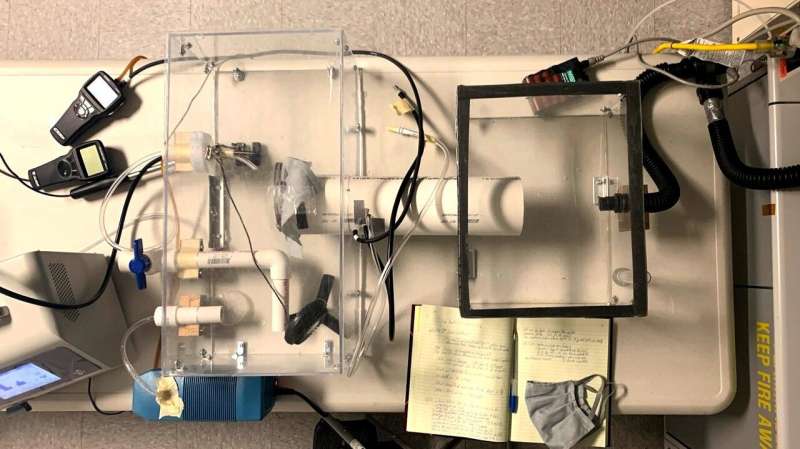Homemade masks made of silk and cotton may boost protection: study

In the wake of the COVID-19 pandemic, the U.S. Centers for Disease Control and Prevention recommends that people wear masks in public. Because N95 and surgical masks are scarce and should be reserved for health care workers, many people are making their own coverings out of fabric. Now, a preliminary study published in ACS Nano by University of Chicago and Argonne National Laboratory researchers suggests that a combination of masks made of high thread-count cotton with natural silk fabric or a chiffon weave can effectively filter out aerosol particles––if the fit is good.
"There is a huge interest and need for homemade cloth masks, but we found little data on how good various fabrics are as filters for masks," said senior author Supratik Guha, professor with the University of Chicago's Pritzker School of Molecular Engineering and a scientist at Argonne. "According to these results, it's possible to get very good filtering with commonly available fabrics, but the wearer only gets maximum protection if the fit is very close to your face."
COVID-19 is thought to spread mainly through respiratory droplets created when an infected person coughs, sneezes, speaks or breathes. Guha and his colleagues wanted to study the ability of common fabrics, alone or in combination, to filter out aerosols similar in size to respiratory droplets. So Guha—in regular times, a leading scientist in microelectronics and materials for quantum information—quickly rigged up an experimental setup with his colleagues to test combinations of fabrics that can be bought at fabric and retail stores.
The experiments took place in two plexiglass boxes connected by a tube. In one chamber, the team created a cloud of particles and blew them toward the tube, which was covered by different combinations of cloth. Mike Schmoldt and Greg Moss, environmental safety experts at Argonne who specialize in respirator testing and the effects of aerosol particles, used laboratory-grade scientific instruments to measured the number and size of particles in the chambers before and after passing through the fabric.
According to their results, one layer of a tightly woven cotton sheet, combined with two layers of polyester-based chiffon—a sheer fabric often used in evening gowns—filtered out the most aerosol particles (80% to 99%, depending on particle size). Substituting the chiffon with natural silk or a polyester-cotton flannel, or simply using a cotton quilt with cotton-polyester batting, produced similar results.
Though the study does not attempt to replicate real-world conditions, the findings are a useful guide. The researchers pointed out that tightly woven fabrics, such as cotton, can act as a mechanical barrier to particles; whereas fabrics that hold a static charge, like certain types of chiffon and natural silk, can serve as an electrostatic barrier. The electrostatic effect serves to suck in and hold the tiniest particles, which might otherwise slip through holes in the cotton. This is key to how N95 masks are constructed.
However, Guha added, even a small gap reduced the filtering efficiency of all masks by half or more, emphasizing the importance of a properly fitted mask.
Fabrics that did not do well included standard polyester and spandex with more open weave. In general, Guha said, fabric with tighter weaves—with fewer gaps between the strands of yarn—worked better.
"This is some of the first methodical data I've seen on homemade masks. It's very helpful to have some idea of how the different types of fabric perform," said Emily Landon, executive medical director of infection prevention and control at the University of Chicago Medicine. "I was also pleasantly surprised by how effective some of the homemade masks can be in the right conditions."
Landon noted that the advice to wear homemade masks while out in public is intended primarily to protect others from your own respiratory droplets, and that universal adoption of this recommendation will go a long way to make everyone safer.
In that case, any mask is better than none.
The first author on the study was Abhiteja Konda with Argonne National Laboratory. The other authors were Argonne's Abhinav Prakash as well as Pritzker School of Molecular Engineering graduate student Gregory Grant. The team used the U.S. Department of Energy's Center for Nanoscale Materials user facility at Argonne National Laboratory.
More information: Abhiteja Konda et al. Aerosol Filtration Efficiency of Common Fabrics Used in Respiratory Cloth Masks, ACS Nano (2020). DOI: 10.1021/acsnano.0c03252




















